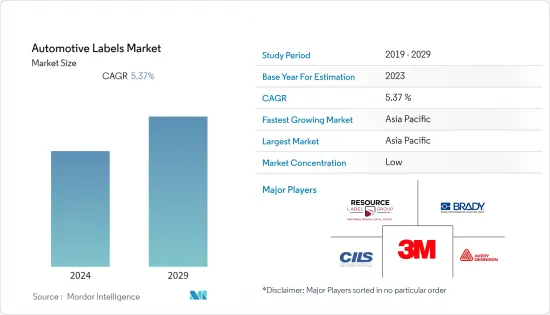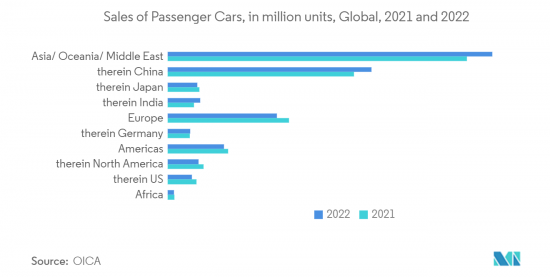 |
市場調査レポート
商品コード
1405345
自動車用ラベル:市場シェア分析、産業動向・統計、成長予測、2024~2029年Automotive Labels - Market Share Analysis, Industry Trends & Statistics, Growth Forecasts 2024 - 2029 |
||||||
● お客様のご希望に応じて、既存データの加工や未掲載情報(例:国別セグメント)の追加などの対応が可能です。 詳細はお問い合わせください。
| 自動車用ラベル:市場シェア分析、産業動向・統計、成長予測、2024~2029年 |
|
出版日: 2024年01月04日
発行: Mordor Intelligence
ページ情報: 英文 129 Pages
納期: 2~3営業日
|
- 全表示
- 概要
- 目次
前年度の自動車用ラベル市場の市場規模は74億1,000万米ドルで、予測期間にはCAGR 5.37%を記録し、101億1,000万米ドルに達すると予測されています。

主なハイライト
- 自動車産業からの自動車へのニーズの高まりと、自動車部品の識別、情報、安全性のための無線自動識別(RFID)やバーコードのようなラベルへの要求が市場を牽引すると予測されます。すべてのエンドユーザー産業におけるパッケージングとラベリング市場の成長により、自動車用ラベル産業は大幅に拡大しています。
- 自動車用ラベルは通常、バーコード、見積もり、車両識別番号(VIN)ラベルなどのバッジやラベルで構成され、部品情報、企業名やロゴ、価格、技術情報、その他の重要な詳細を表示します。市場成長を促進すると予想されるその他の要因としては、RFIDやバーコードなどのスマートラベルに対する需要の増加、環境に優しいラベル製造方法に対する需要の高まりなどが挙げられます。
- 乗用車における自動車用ラベルの利用が増加していることは、市場成長を促進する主な要因の1つです。さらに、自動車製造設備への投資の増加や乗用車の生産台数の増加が、自動車用ラベル市場の需要を促進している主な要因となっています。また、自動車用ラベル市場は、ほぼすべての産業で発生している技術開発により拡大しています。自律走行プラットフォームが生成する何百万もの写真や動画を適切に分類することが重要です。
- 自動車業界には、クリーニング用品や自動車メーカーからF1や公共交通機関に至るまで、多くのラベリング要件があります。この業界では、外装やエンジンなど、自動車のほぼすべての領域でラベルが使用されています。この分野では、始動モーター、ケーブル、ポンプ、モーター、エンジン管理システムなどに自動車用ラベルが使用されることがあります。
- 自動車用ラベルの市場が成長し続けるにつれて、インク部品に対する世界のコンプライアンス規制も厳しくなっています。その結果、配合者にとって、このような市場に適合し、デザインインクとなりうる要素とは異なる成分を選択することは、複雑で困難な課題となっています。このことと、各国における生産コストの上昇が、市場の成長を妨げると予想されます。
- 自動車用ラベルメーカーは、差し迫った危機に対応し、COVID-19以降の新しい仕事の方法を見つけることから、自社の事業とサプライチェーンを保護することが期待されています。しかし、ラベルは必需品のサプライチェーンの一部です。さらに、情報を伝達するための重要なツールとしての役割も果たしています。さらに、自動車用ラベル市場は、業界の技術的変化に先行しています。自律走行プラットフォームは、最高レベルの精度でラベル付けされるべき何億もの画像や動画を生成します。
自動車用ラベル市場の動向
バーコードセグメントが主要市場シェアを占める
- バーコードラベルは、データの保存と検索に高速な方法を提供します。バーコードラベルには、会社や製品の詳細が行や番号の形式で記載されています。バーコードラベルは、トレーサビリティを提供することにより、在庫管理やリコール負担の軽減にも使用できます。自動車用ラベルのバーコードは、エンジン、ドア、ダッシュボードなどの部品に見られます。
- 2次元バーコードは、自動車部品のラベルに使用される最も一般的なバーコードの種類の1つです。ラベリングは、自動車部品メーカーのサプライチェーンにおいて重要な役割を果たしています。製品の正確な配送を保証し、重要なバーコードやその他の情報を提供し、商品の移動を加速します。顧客固有のニーズや新興市場の販売業者のブランド要件から、輸出入管理や税関監査に至るまで、ラベリングには労力とコストがかかります。
- 一方、3Dスキャナーはバーコードの3Dスキャンを生成します。このスキャンは、どの方向からでも読み取ることができます。3Dバーコードスキャナーは、自動車の組み立てや製造などの産業用アプリケーションで一般的に使用されています。
- 複数のメーカーが自動車用バーコードラベルを幅広く提供しています。例えば、メタルクラフト社は、様々な用途のプラスチックバーコードラベルを製造しています。フロントガラス、ケーブル、ワイヤー、ダッシュボードなどに使用できます。また、タンパーエビデントラベルや金属化ラベルもあり、他にも多数あります。
- 自動車部品や自動車在庫のラベリングは、自動車や自動車部品を生産する上で重要です。自動車メーカーは、倉庫内の製品を追跡し、サードパーティロジスティクス(3PL)サプライヤーからの在庫をチェックするためにバーコードを使用しています。彼らはまた、シリアル番号、日付、モデルなどの他の幅広い情報を持つ部品を識別するためにバーコード(印刷されたバーコード付き)を使用しています。
- バーコードプリンターやスキャナーは、これらのバーコードを印刷し、製品に貼付するラベルを作成することができます。これは在庫の追跡に役立ち、ミスや重要な情報の欠落のリスクを最小限に抑えます。OICAによると、今年の軽自動車の販売台数は4.73%増加すると予想されています。全体として、成長する自動車産業が市場の成長を助けると予想されます。

アジア太平洋地域が市場を独占する見込み
- アジア太平洋地域が大きな市場シェアを占めており、予測期間中に最も高い成長が見込まれます。Avery Dennisonのような企業が、ラベルやパッケージング産業を成長させ、イノベーション能力を高めるために、この地域で新興企業を増やしていることが、市場の成長を後押しする重要な要因となっています。
- 自動車アフターセールス市場の成長は、中国における自動車生産・販売の増加や自動車部品産業の拡大など、さまざまな要因によるものです。さらに、エンジンアフターセールス市場は、顧客中心のカスタマイズの増加や中古車市場によって、予測期間中に堅調な成長率を記録すると予測されています。アフターセールス分野では、部品の交換、メンテナンスや修理サービスの提供、安全性の確保、法規制の遵守などにラベルが活用されます。市場の拡大に伴い、エンジンラベルやその他の自動車用ラベルの需要も増加すると思われます。
- インドの自動車産業は、マクロ経済の拡大と技術開発の両面で大きな役割を果たしているため、経済の好調さを示す優れた指標となっています。中産階級が増加し、若年人口が大きな割合を占めるインドでは、二輪車セグメントが台数ベースで市場を独占しています。この分野の成長は、地域市場を開拓しようとする企業の関心の高まりにも支えられています。その結果、自動車の生産台数が増加しています。自動車産業が成長を続けるにつれて、ラベルを含む自動車部品の需要も増加すると予想されます。
- 日本政府は、無線自動識別(RFID)を大規模な財政投資に支えられた革新的技術として認識しており、日本における強力な生産基盤が今後数年間、RFIDアプリケーションで主導的な役割を果たすことを確実にしています。RFID技術の大幅な進歩は、政府の支援に基づいて達成することができます。これは、自動車分野での使用に適した、より高度で効果的なRFIDにつながる可能性があります。
- 日本自動車工業会によると、日本の自動車メーカーは2022年に日本国外の生産施設で約1,696万台の自動車を生産し、前年の1,646万台から増加しました。日本国外での生産拡大は、日本の自動車メーカーによる世界拡大戦略を示しています。自動車メーカーが海外市場でより強いプレゼンスを確立するにつれて、さまざまな地域や言語の独自の要件に対応するための特殊なラベルが必要になる可能性があり、自動車用ラベル市場の需要をさらに押し上げます。
自動車用ラベル産業の概要
3M Company、Avery Dennison Corporation、Resource Label Group、H.B. Fuller Companyなど、複数の大手企業が存在するため、市場は断片化しています。このような大手プレイヤーの関与によって特徴付けられる、進化する業界情勢は、新たな機会を捉えようと努力する企業間の競争を激化させています。同時に、中小企業も成長軌道に乗り、市場の大幅な成長の可能性を利用しようとしています。
その他の特典:
- エクセル形式の市場予測(ME)シート
- 3ヶ月間のアナリストサポート
目次
第1章 イントロダクション
- 調査の前提条件と市場定義
- 調査範囲
第2章 調査手法
第3章 エグゼクティブサマリー
第4章 市場洞察
- 市場概要
- 業界の魅力度-ポーターのファイブフォース分析
- 供給企業の交渉力
- 買い手の交渉力
- 新規参入業者の脅威
- 代替品の脅威
- 競争企業間の敵対関係
- 業界バリューチェーン分析
- COVID-19の市場への影響
第5章 市場力学
- 市場促進要因
- 自動車産業におけるRFIDラベル需要の増加
- ラベルに関する法規制への対応の増加
- 市場抑制要因
- 小規模メーカーの製造コスト増大
第6章 市場セグメンテーション
- 識別技術別
- バーコード
- QRコード
- RFIDタグ
- その他
- タイプ別
- ブランディング
- トラック・トレース
- 警告・安全
- 資産ラベル
- その他のタイプ(タイヤ用ラベル、耐候性ラベル)
- 用途別
- インテリア用途
- 外装用途
- エンジン用途
- その他
- 地域別
- 北米
- 米国
- カナダ
- 欧州
- 英国
- ドイツ
- フランス
- スペイン
- その他欧州
- アジア太平洋
- 中国
- インド
- 日本
- その他アジア太平洋地域
- ラテンアメリカ
- 中東・アフリカ
- 北米
第7章 競合情勢
- 企業プロファイル
- 3M Company
- Avery Dennison Corporation
- Resource Label Group LLC
- CILS International
- Brady Worldwide Inc.
- Asean Pack
- Polyonics Inc.
- Imagetek Labels
- Weber Packaging Solutions
- Advantage Label & Packaging Inc.
- Label-Aid Systems Inc.
- Clarion Safety Systems
第8章 投資分析
第9章 市場の将来

The automotive labels market was valued at USD 7.41 billion the previous year and is expected to register a CAGR of 5.37%, reaching USD 10.11 billion over the forecast period.
Key Highlights
- The increasing need for vehicles from the automotive industry and the requirement for labels like radio-frequency identification (RFID) and bar codes for the automotive part's identification, information, and safety are anticipated to drive the market. Due to the growth of the packaging and labeling markets across all end-user industries, the automotive labels industry is expanding significantly.
- Automotive labels typically consist of badging and labels, such as barcode, estimate, and vehicle identification number (VIN) labels, that display component information, a company's name and logo, price, technical information, and other important details. Additional factors anticipated to fuel market growth include the increased demand for smart labels, such as RFID and barcodes, and the rising demand for eco-friendly label production methods.
- The increasing utilization of automotive labels in passenger cars is one of the key factors driving the market growth. Moreover, the increasing investments in automobile manufacturing facilities and rising passenger car production are key factors fostering the market demand for automotive labels. The market for automotive labels market is also expanding due to technical developments occurring in almost every industry. It's important to properly categorize the millions of photos and videos that autonomous driving platforms produce.
- The automotive industry has many labeling requirements, from cleaning supplies and car producers to Formula 1 and public transportation. There are labels used in this industry in almost every area of a car, including the exterior and the engine. In this sector, automotive labeling may be used on starting motors, cables, pumps, motors, and engine management systems, among other things.
- As the market for automotive labels continues to grow, so too are the global compliance regulations for ink components. As a result, it has become complex and challenging for formulators to select ingredients to meet such a market and are different from the elements that could be a design ink. This and rising production costs in various countries are expected to hinder the market's growth.
- Automotive label manufacturers are expected to protect their operations and supply chain from meeting the impending crisis and finding new ways of working post-COVID-19. However, the labels are part of the supply chains of necessities. Additionally, they serve as a critical tool for conveying information. Furthermore, the automotive labels market is in advance with technological changes in the industry. Autonomous driving platforms generate hundreds of millions of images and videos to be labeled with the highest levels of accuracy.
Automotive Labels Market Trends
Barcode Segment to Hold Major Market Share
- Barcode labels provide a fast way to store and retrieve data. Barcode labels contain company and product details in line and number formats. Barcode labels can also be used to manage inventory and reduce the recall burden by providing traceability. Automotive barcodes on automotive labels can be found on parts of engines, doors, dashboards, and more.
- The 2D barcode is one of the most common types of barcode used to label car parts. Labeling plays a critical role in the supply chain of a car part manufacturer. It guarantees a product's accurate delivery, provides important barcodes and other information, and accelerates the movement of goods; from customer-specific needs and branding requirements for distributors in emerging markets to import and export controls and customs audits, labeling can be labor-intensive and expensive.
- On the other hand, 3D scanners generate a 3D scan of the bar code. This scan can be read from any direction. 3D barcode scanners are commonly used in industrial applications such as automotive assembly and manufacturing.
- Several manufacturers provide a wide range of automotive barcode labels. For instance, Metalcraft, Inc. manufactures plastic barcode labels that come in various applications. They can be used on windshields, cables, wires, dashboards, etc. Also, there are tamper-evident and metalized labels, many others.
- Car parts and automotive inventory labeling are important in producing cars and car parts. Car manufacturers use barcodes to keep track of products in their warehouses and to check inventory from their third-party logistics (3PL) suppliers. They also use barcodes (with printed barcodes) to identify parts with a wide range of other information, including serial numbers, dates, and models.
- Barcode printers or scanners can print these barcodes to produce the label applied to a product. This helps track inventory and minimizes the risk of mistakes or missing important information. According to OICA, the sales of light vehicles are expected to increase by 4.73% this year. Overall, the growing automotive industry is expected to aid the market's growth.

Asia-Pacific Expected to Dominate the Market
- The Asia-Pacific region holds a major market share and is expected to witness the highest growth over the forecast period. The growing number of startups in the region by companies like Avery Dennison to grow the labels and packaging industry and boost its innovation abilities is a significant factor aiding the market's growth.
- The automotive after-sales market's growth is attributed to various factors, including increased vehicle production and sales in China and the expansion of the automotive components industry. Additionally, the market for engine after-sales is projected to experience a robust growth rate over the forecast period, driven by an increase in customer-centric customization and the market for used cars. Within the after-sales segment, labels are utilized to replace parts, provide maintenance and repair services, ensure safety, and adhere to regulations. As the market continues to expand, there is likely to be a corresponding increase in the demand for engine and other automotive labels.
- As the Indian automotive industry plays a major role in both macroeconomic expansion and technological development, it has been an excellent indicator of how well the economy is doing. Due to the growing middle class and a large proportion of India's young population, the two-wheeler segment dominates the market in terms of volume. The sector's growth is also supported by increased interest by businesses to explore regional markets. This has resulted in an increase in the production of vehicles. As the automotive industry continues to grow, the demand for automotive parts, including labels, is also expected to increase.
- The Japanese government recognizes radio-frequency identification (RFID) as an innovative technology supported by major financial investment to ensure that the strong production base in Japan will play a leading role in RFID applications over the coming years. Significant advances in RFID technology can be achieved based on government support. This could lead to more advanced and effective RFID, which would be better suited for use in the automotive sector.
- According to the Japan Automobile Manufacturers Association Inc., in 2022, Japanese automakers manufactured around 16.96 million vehicles at production facilities outside of Japan, increasing from 16.46 million in the previous year. Expanding production outside Japan indicates a global expansion strategy by Japanese automakers. As they establish a stronger presence in foreign markets, they may require specialized labels to cater to the unique requirements of different regions and languages, further driving demand in the automotive labels market.
Automotive Labels Industry Overview
The market exhibits fragmentation due to the presence of several major players, including 3M Company, Avery Dennison Corporation, Resource Label Group, H.B. Fuller Company, and more. This evolving industry landscape, characterized by the involvement of these major players, has intensified competition among companies striving to seize emerging opportunities. Simultaneously, smaller firms are on a growth trajectory, seeking to harness the market's substantial growth potential.
In June 2023, Avery Dennison Corporation announced a strategic collaboration with Emerald Technology Ventures focused on Industrial, Sustainable, and New Packaging Materials Technologies. This collaboration represents a significant step towards advancing Avery Dennison's innovation and sustainability objectives.
Furthermore, in October 2022, Resource Label Group bolstered its presence in the Midwest and reinforced its leadership in the label and packaging industry by acquiring Deco Flexible Packaging, a Chicago-based company. This acquisition marked the twenty-fourth addition to Resource Label Group's expanding portfolio.
Additional Benefits:
- The market estimate (ME) sheet in Excel format
- 3 months of analyst support
TABLE OF CONTENTS
1 INTRODUCTION
- 1.1 Study Assumptions and Market Definition
- 1.2 Scope of the Study
2 RESEARCH METHODOLOGY
3 EXECUTIVE SUMMARY
4 MARKET INSIGHTS
- 4.1 Market Overview
- 4.2 Industry Attractiveness - Porter's Five Forces Analysis
- 4.2.1 Bargaining Power of Suppliers
- 4.2.2 Bargaining Power of Buyers
- 4.2.3 Threat of New Entrants
- 4.2.4 Threat of Substitutes
- 4.2.5 Intensity of Competitive Rivalry
- 4.3 Industry Value Chain Analysis
- 4.4 Impact of COVID-19 on the Market
5 MARKET DYNAMICS
- 5.1 Market Drivers
- 5.1.1 Growing Demand From the Automotive Industry for RFID Labels
- 5.1.2 Increasing Compliance With Label Laws
- 5.2 Market Restraints
- 5.2.1 Cost of Manufacturing Greater for Small Manufacturers
6 MARKET SEGMENTATION
- 6.1 By Identification Technology
- 6.1.1 Barcode
- 6.1.2 QR Code
- 6.1.3 RFID Tags
- 6.1.4 Other Identification Technologies
- 6.2 By Type
- 6.2.1 Branding
- 6.2.2 Track & Trace
- 6.2.3 Warning & Safety
- 6.2.4 Asset Labels
- 6.2.5 Other Types (Tire Labels, Weatherproof Labels)
- 6.3 By Application
- 6.3.1 Interior Applications
- 6.3.2 Exterior Applications
- 6.3.3 Engine Applications
- 6.3.4 Other Applications
- 6.4 By Geography
- 6.4.1 North America
- 6.4.1.1 United States
- 6.4.1.2 Canada
- 6.4.2 Europe
- 6.4.2.1 United Kingdom
- 6.4.2.2 Germany
- 6.4.2.3 France
- 6.4.2.4 Spain
- 6.4.2.5 Rest of Europe
- 6.4.3 Asia-Pacific
- 6.4.3.1 China
- 6.4.3.2 India
- 6.4.3.3 Japan
- 6.4.3.4 Rest of Asia-Pacific
- 6.4.4 Latin America
- 6.4.5 Middle East and Africa
- 6.4.1 North America
7 COMPETITIVE LANDSCAPE
- 7.1 Company Profiles*
- 7.1.1 3M Company
- 7.1.2 Avery Dennison Corporation
- 7.1.3 Resource Label Group LLC
- 7.1.4 CILS International
- 7.1.5 Brady Worldwide Inc.
- 7.1.6 Asean Pack
- 7.1.7 Polyonics Inc.
- 7.1.8 Imagetek Labels
- 7.1.9 Weber Packaging Solutions
- 7.1.10 Advantage Label & Packaging Inc.
- 7.1.11 Label-Aid Systems Inc.
- 7.1.12 Clarion Safety Systems
